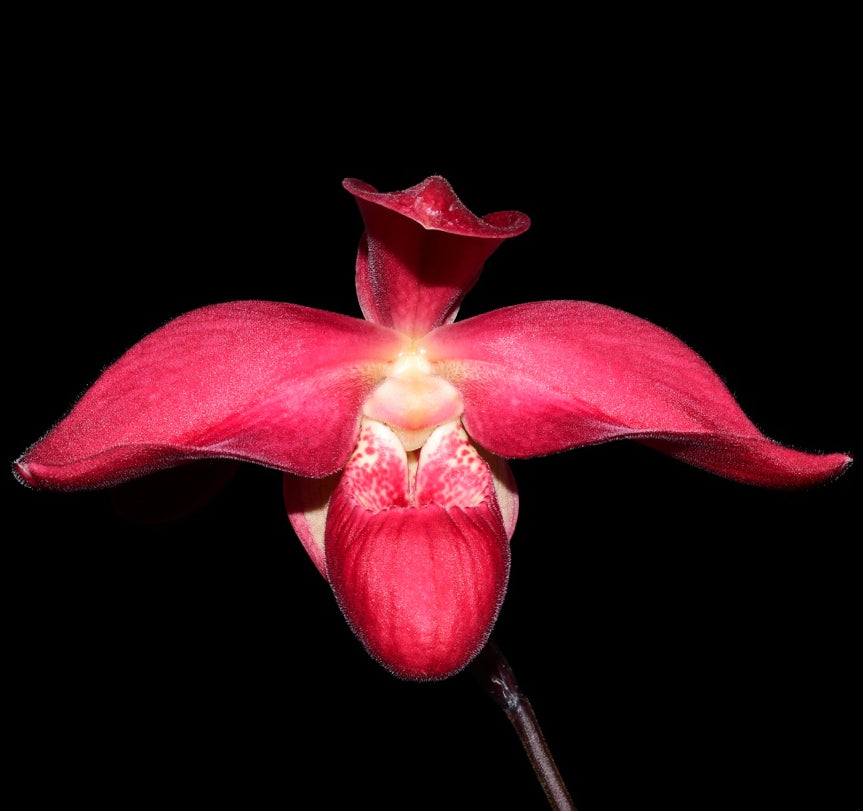
Phragmipedium Keyla Aalarcon
Phragmipedium Keyla Alarcón is the most recent creation of Ecuagenera, a company dedicated to the research, conservation, production and biotrade of orchids and other exotic plants.
The new hybrid is the result of Phragmipedium kovachii x Phragmipedium Ruby Slippers. It bloomed in the first week of April of this year in the Ecuagenera-Gualaceo nurseries. The company registered it last April 12 in the International Orchid Register.
It is a plant that adapts to intermediate climates. In this one the genes of the father (Phragmipedium Ruby Slippers) predominate, which gave it an attractive reddish color in its large flowers.
The specimen was named in honor of engineer Keyla Alarcón, a lover of orchid flora cultivation, who in recent years has organized several orchid exhibition events, the most recent being the "I Exhibition of Orchids Cañar 2022".
Cultivation
For the cultivation of the different orchids, Ecuagenera standardizes the processes. For this, it uses chopped pine bark in different sizes, according to the species and size of the plants. Also, pumice stone is an ally to achieve more aeration in the roots, since this rock is light and porous, and therefore, contains a lot of oxygen.
In addition, it is important to consider the habitats where the orchids come from. In this case, Phragmipedium Keyla Alarcón, can remain in an environment with temperatures between 12 and 22 °C (54 and 72 °F).
For Phragmipedium it is possible to use different culture media, depending on the place where they are found. It is important to take into account the type of water in the area, since this genus requires pH levels of 5.5 (similar to rainwater). In addition, it is essential to provide good drainage and adequate ventilation.
Hybridization
In order to improve the genetics of the plants and facilitate their cultivation, Ecuagenera carries out permanent hybridization processes.
In the case of Phragmipedium, this process takes between four and five years, from the time the plants are pollinated until they begin to flower. In addition, it is important to emphasize that for hybridization to be successful, the specimens must belong to the same subtribe.
So far, Ecuagenera has registered more than 100 hybrids, which are positioned as favorites within the national market.
Information about the parents of Phragmipedium Keyla Alarcón
The mother of this hybrid is Phragmipedium kovachii, a species native to the montane forests of Peru. It grows in cold climate, with intermediate humidity.
The father is Phragmipedium Ruby Slippers, a hybrid resulting from the cross between Phragmipedium caudatum and Phragmipedium besseae.
The genus Phragmipedium
This genus was created by Robert Rolfe in 1896. The name derives from the Greek terms "phragma" meaning "divided", and "pedilon" meaning "shoe". Thus, allusion is made to the trilocular ovary and the shape of the lip.
Phragmipediums have a sack-shaped lip (shoe), folded inward at the edges, which makes it difficult for insects (pollinators) to get out.
The odors emanating from certain species attract insects to fall into the labellum. Once there, the only internal part through which it is possible to escape includes the reproductive part of the plant. Thus, in an attempt to free themselves, the insects manipulate the pollen with their backs and give rise to pollination.
This genus is found in different habitats. The plants can grow in epiphytic (about two species documented so far), lithophytic and terrestrial forms. Phragmipedium flowers have a wide variety of colors, mostly in shades of green, brown and pink. Some of the most striking species have red and purple-purple colors.
Species have been selected for hybridization to create more durable and colorful flowers, which are sought after worldwide.
In general, an individual flower lasts a few weeks. When the first flower falls off, the spike should not be cut. The inflorescence of many species bears flowers in succession so that its bloom can extend from two to six months. Once the inflorescence is brown and has dried, the spike can be cut.
The new hybrid is the result of Phragmipedium kovachii x Phragmipedium Ruby Slippers. It bloomed in the first week of April of this year in the Ecuagenera-Gualaceo nurseries. The company registered it last April 12 in the International Orchid Register.
It is a plant that adapts to intermediate climates. In this one the genes of the father (Phragmipedium Ruby Slippers) predominate, which gave it an attractive reddish color in its large flowers.
The specimen was named in honor of engineer Keyla Alarcón, a lover of orchid flora cultivation, who in recent years has organized several orchid exhibition events, the most recent being the "I Exhibition of Orchids Cañar 2022".
Cultivation
For the cultivation of the different orchids, Ecuagenera standardizes the processes. For this, it uses chopped pine bark in different sizes, according to the species and size of the plants. Also, pumice stone is an ally to achieve more aeration in the roots, since this rock is light and porous, and therefore, contains a lot of oxygen.
In addition, it is important to consider the habitats where the orchids come from. In this case, Phragmipedium Keyla Alarcón, can remain in an environment with temperatures between 12 and 22 °C (54 and 72 °F).
For Phragmipedium it is possible to use different culture media, depending on the place where they are found. It is important to take into account the type of water in the area, since this genus requires pH levels of 5.5 (similar to rainwater). In addition, it is essential to provide good drainage and adequate ventilation.
Hybridization
In order to improve the genetics of the plants and facilitate their cultivation, Ecuagenera carries out permanent hybridization processes.
In the case of Phragmipedium, this process takes between four and five years, from the time the plants are pollinated until they begin to flower. In addition, it is important to emphasize that for hybridization to be successful, the specimens must belong to the same subtribe.
So far, Ecuagenera has registered more than 100 hybrids, which are positioned as favorites within the national market.
Information about the parents of Phragmipedium Keyla Alarcón
The mother of this hybrid is Phragmipedium kovachii, a species native to the montane forests of Peru. It grows in cold climate, with intermediate humidity.
The father is Phragmipedium Ruby Slippers, a hybrid resulting from the cross between Phragmipedium caudatum and Phragmipedium besseae.
The genus Phragmipedium
This genus was created by Robert Rolfe in 1896. The name derives from the Greek terms "phragma" meaning "divided", and "pedilon" meaning "shoe". Thus, allusion is made to the trilocular ovary and the shape of the lip.
Phragmipediums have a sack-shaped lip (shoe), folded inward at the edges, which makes it difficult for insects (pollinators) to get out.
The odors emanating from certain species attract insects to fall into the labellum. Once there, the only internal part through which it is possible to escape includes the reproductive part of the plant. Thus, in an attempt to free themselves, the insects manipulate the pollen with their backs and give rise to pollination.
This genus is found in different habitats. The plants can grow in epiphytic (about two species documented so far), lithophytic and terrestrial forms. Phragmipedium flowers have a wide variety of colors, mostly in shades of green, brown and pink. Some of the most striking species have red and purple-purple colors.
Species have been selected for hybridization to create more durable and colorful flowers, which are sought after worldwide.
In general, an individual flower lasts a few weeks. When the first flower falls off, the spike should not be cut. The inflorescence of many species bears flowers in succession so that its bloom can extend from two to six months. Once the inflorescence is brown and has dried, the spike can be cut.
